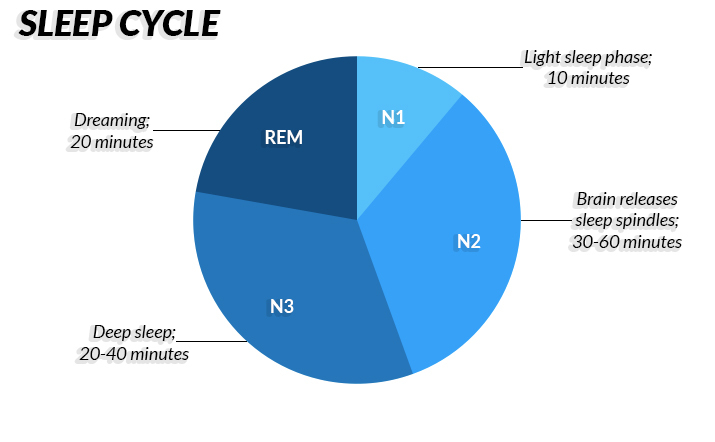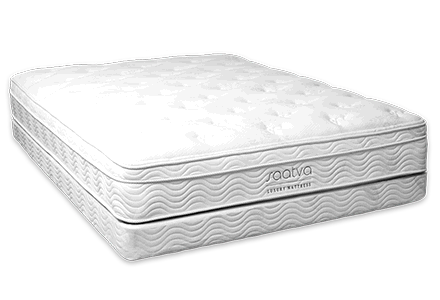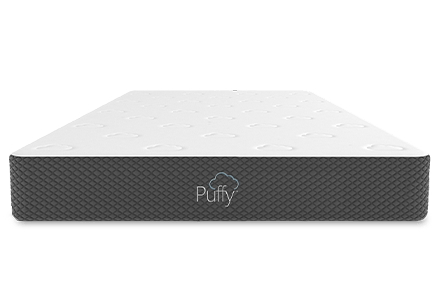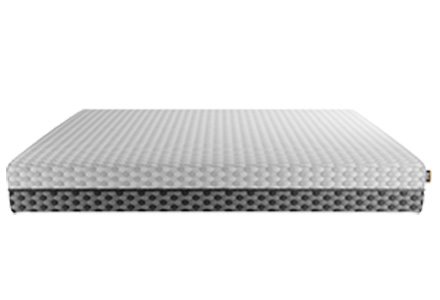MyBestMattress is an independent, personal project. All the content on this website is free to use.
You can help keep the site free & unbiased by donating. Your support is highly appreciated!
What Is a Sleep Calculator?
A sleep calculator is a tool used to determine what time to go to bed so you can get a certain amount of quality sleep. It’s a simple-to-use calculator that helps you figure out how your current sleep patterns can be adjusted to help you feel better in the morning.
Perhaps you’ve completely reset your sleep pattern spending all-nighters preparing for your exams. Or you have a flight at odd hours of the day and want to know what is the best time to wake up so that jet lag doesn’t knock you out. Maybe you struggle falling asleep and always feel more tired in the morning than you’d like.
Our sleep calculator takes several criteria into consideration to determine what the best time to go to sleep is for you. These criteria are:
- What time you want to go to bed;
- What time you want to wake up;
- How old you are;
- How long it approximately takes for you to fall asleep.
According to this data, the sleep calc will answer one of the two questions you may have – what time to go to bed or what time to wake up to get the most satisfying amount of sleep. Since the amount of sleep required varies based on your own biological clock, this data is an approximation and may be adjusted to your preferences.
This tool is not only useful for setting up a sleep routine, but for one-off sleep changes as well. If you need to wake up at a particular time that clashes with your usual sleep schedule, you can simply enter your data and press “Calculate”.
Disclaimer: The sleep calculator is not a cure for sleep disorders and should not be used as a replacement to medical advice. Please consult a medical professional if you experience sleep disturbances that may require medication or further intervention.
What Is a Sleep Cycle?
It’s very unlikely that you fall asleep as soon as your head hits the pillow. Even if some nights it feels like you’ve spent the whole time dreaming, it actually takes some time for that sleep phase to kick in.
In fact, humans sleep in cycles. Each cycle consists of 4 sleep stages. The first three stages are considered NREM, or “non-rapid eye movement sleep”, while the final phase is REM, which stands for “rapid eye movement”.
The four stages of sleep that make up a single cycle are:
- N1 – the early stage, or light sleep. It lasts only about 10 minutes, just after you fall asleep;
- N2 – the middle stage that lasts about 30-60 minutes. The muscles of your body relax. Your brain starts releasing sleep spindles, which are waves of neural activity that help you process the events of the day, and everything you’ve learned throughout it;
- N3 – the deep sleep phase. This is perhaps the most important time of the sleep cycle when the brain activity spikes up. An uninterrupted N3 phase lasts anywhere between 20-40 minutes and this time decreases with each cycle;
- REM – the final phase is the time when you might start dreaming. This sleep phase starts roughly 60-90 minutes after falling asleep and sees the brain reaching its peak activity. It gets longer with each sleep cycle and should account for about 20-25% of your total sleep time.
A full night’s rest usually lasts about 5 sleep cycles, though it depends on each person. However, it’s important to avoid waking up during the N3 and the REM phases because that isn’t very good for your wellbeing.
During the deep sleep phase, your body relaxes and recovers from any fatigue, injuries or illnesses. This is an essential part of your sleep cycle, and waking up in the middle of this phase can lead to disorientation or disruption of bodily processes.
This is also why it’s recommended to avoid napping for more than 30-45 minutes. Any longer, and you run the risk of slipping into deep sleep and waking up feeling very disoriented.

Usually, it’s best to wake up after the REM cycle ends, since the N1 phase is when you sleep the lightest and you won’t feel like you were ripped out of the dreamland. Not getting enough REM sleep can affect not just your physical wellbeing, but also your mental state.
If you struggle getting much sleep, but want to make sure you complete your sleep cycles and don’t wake up in the middle of one—thus making you feel even more tired than when you went to bed—our sleep calc can help you out.
Using our tool as a REM calculator, you can insert the data based on how long you think your sleep cycle lasts, on average. Then, you can adjust the output and decide if you need more or less sleep to wake up after a cycle is completed, and not in the middle of it.
Simply select your bedtime, and the calculator will show you what time to wake up is the best to make sure you complete at least one deep sleep cycle.
How Much Sleep Do You Need?
This is a big question for anyone – how much sleep do you need to feel sufficiently rested in the morning?
The answer might not seem satisfactory – it depends. There are a bunch of criteria that can affect how much sleep we need individually. That can be anything – from genetics, gender, health or age, to how many cups of coffee you’ve had today or how stressful your week has been. How much sleep you need might even fluctuate from week to week in some stages of your life.
Let’s start with one of the biggest factors – age. It’s no secret that babies spend most of their days either eating or sleeping. Well, this is the stage of our lives when we require the most sleep. Babies grow very quickly and most of their developmental processing happens while they’re asleep.
These changes don’t slow down until we reach prepubescence. Even if both start their activities at the same time – 8 a.m., for example – figuring out what time should 10-year-olds go to bed and what time should kindergarteners go to bed varies pretty drastically.
Kindergarteners are also a pretty varied age group, so let’s take 5-year-olds as an example. On average, they require around 10-13 hours of sleep to be fully rested. Meanwhile, a 10-year old could feel refreshed after 9 hours of sleep.
So, the best time to go to sleep for the older children would be around 9-10 p.m., while for the kindergarteners bedtime should be at around 7-8 p.m.
| ESTIMATED BEDTIME | ESTIMATED TIME TO WAKE UP | |||
|---|---|---|---|---|
| 7-HOUR CYCLE | 9-HOUR CYCLE | 12-HOUR CYCLE | 15-HOUR CYCLE | |
| 7 P.M. | 2 A.M. | 4 A.M. | 7 A.M. | 10 A.M. |
| 8 P.M. | 8 A.M. | 3 A.M. | 8 A.M. | 11 A.M. |
| 9 P.M. | 4 A.M. | 6 A.M. | 9 A.M. | 12 A.M. |
| 10 P.M. | 5 A.M. | 7 A.M. | 10 A.M. | 1 P.M. |
| 11 P.M. | 6 A.M. | 8 A.M. | 11 A.M. | 2 P.M. |
| 12 A.M. | 7 A.M. | 9 A.M. | 12 P.M. | 3 P.M. |
Sleeping that long might sound a bit ridiculous for adults. Let’s do some maths – can we figure out what time to wake up for a 20-something who went to sleep at 7 p.m.? Sometime around 4 a.m. In fact, you can test out the sleep calculator and see if you get the same answer!
The overall amount of sleep you require changes as you get older – this is particularly true for the amount of REM sleep. Newborns spend about 80% of their sleep time in the REM stage. By the time we reach full maturity, that number plummets down to 20%.
So, it’s possible that in 5 years your personal sleep requirements will be very different from today. A how-much-sleep-do-I-need calculator can help you not only rest better today, but to keep track of changes in your patterns long-term.
In order to know what best suits your needs, check out the sleep calculator above and see what the suggestions are. You can also use our sleep calc tool to adjust the bedtime of your children based on their age to figure out what best time to go to sleep for each family member is.
The Importance of Getting Enough Sleep
So, why is getting enough sleep so important, and why are tools like the sleep calculator useful in achieving that?
First and foremost, the core reason why you should get enough sleep is your wellbeing. Sleep isn’t just the time to relax after a long day. You’ll often hear people say that sleep resets your brain. But what does that entail, exactly?
Well, as you can see in the overview of the sleep cycles, while we rest, our brains process the events of the day. Everything we’ve learned, seen, experienced settles into place so we can easily recall it.
If you’re not getting enough sleep, it’s likely you’re waking up in the middle of one of the sleep cycles instead of at the end. Have you ever felt so disoriented you couldn’t tell if you were still dreaming? That’s what waking up while your brain is processing information can feel like.
Not getting enough sleep can lead to a number of sleep issues – from hallucinations and night terrors to insomnia. These problems can even depend on which stage of your sleep cycle is interrupted!
Furthermore, it’s not just lacking sleep that’s bad. Oversleeping can leave you feeling just as unpleasant. If you sleep for too long, it might also mean that you wake up at odd points of the sleep cycle.
| DO | DON'T |
|---|---|
| Relax and rest your brain | Work or study in bed |
| Drink non-caffeinated herbal tea | Drink coffee, energy drinks or alcohol |
| Meditate or do light yoga | Follow an intense workout routine |
| Listen to white noise or calm music | Play video games or watch movies |
| Use an analog alarm | Use your phone, tablet or laptop in bed |
| Use your bed for full night’s rest only | Nap in your bed or nap for more than 45 mins |
| Follow a regular sleep schedule | Undersleep or oversleep |
| Get up if you can’t fall asleep immediately | Force yourself to sleep |
| Sleep in a dark environment | Leave all the lights on |
| Sleep on a comfortable, good-quality mattress | Sleep on an old mattress that causes physical discomfort |
This is where the sleep calculator can really come in handy. Adjusting it based on what is the best time to wake up for you—rather than the best time to go to sleep—can help you figure out when to start the cycle. This way, the REM calculator will help you plan ahead to get enough of that dreamy sleep state for the night.
Consider adjusting what time to wake up so you don’t feel drowsy from too much sleep in the morning. Select your preferred time to rise on the sleep calculator. Try following a new schedule for a short while and see if it works for you!
If you’re unsure if you’re getting enough (or too much) sleep, simply put your data into the sleep calculator and compare the results to your current schedule. Does the recommended time align with your personal preferences?
If not, it may be time to start taking steps to change up things and improve your sleep quality.
So, it’s important to get enough sleep to keep your brain and body happy and healthy. And since both undersleeping and oversleeping can lower the chances of you being well-rested, try out what the sleep cycle calculator has to offer.
How Can You Improve Your Sleep Quality?
You can’t go from having trouble sleeping to a perfect nightly routine in just one evening. Notice how I say ‘routine’? That’s exactly what sleep is – like exercise or really any discipline, you need to build up the right habits to sleep well.
While using a sleep calculator to determine the hours you spend asleep is very useful, it’s also about the hours leading up to bedtime – and even a couple of hours after you’ve woken up. Do you feel groggier when your blinds are shut completely, or do the street lights make it harder to keep your eyes closed?
It’s not just about the being asleep part. It’s about what you do before and after you go to bed to set your circadian rhythm (your body rhythm that tells you when you should be awake and when to feel sleepy) into place. I’m talking about the habits and behaviors that we call sleep hygiene.
| TIME | ACTIVITY |
|---|---|
| 4 HOURS BEFORE BED | Limit caffeine and other stimulants |
| 3 HOURS BEFORE BED | Recommended dinner time |
| 1 HOURS BEFORE BED | Limit blue light exposure |
| 30 MINUTES BEFORE BED | Meditate / do yoga |
| 5 MINUTES AFTER WAKING UP | Open the curtains for natural light |
| 1 HOUR AFTER WAKING UP | Recommended breakfast time |
But how do you tell good sleep hygiene apart from the bad? What habits do you need to nurture to improve your sleep quality? Well, it’s easier than it might seem! While it takes time to develop good sleep habits, they’re actually quite simple and can even be fun to keep up.
Let’s take a look at some of the tips and tricks that can improve your sleep quality and help you feel fresh in the morning:
Avoid screentime before bed
This one might be one of the trickier habits to adjust. After all, many of us use our phones as alarms or keep a tablet nearby to watch just one more episode of that thrilling new show. However, blue light emitted by these devices is one of the biggest intrusions of good sleep hygiene.
It’s not just an issue for working adults, either. According to pediatric research, the use of electronic devices immediately before bedtime significantly decreases sleep quality and can negatively impact the physical and psychological development of children and teens.
That sounds pretty dire, especially when you consider that around 60% of kids and teens in the US use their phones or tablets right before bedtime. Determining what time should 11-year-olds go to bed is even more difficult when sleep is tied directly to screen use.
The solution? Well, it’s quite straightforward – reducing the amount of screen time before bed. Of course, this probably isn’t going to happen overnight. You can start by setting the devices to a warmer filter after sunset. That way, the blue light exposure is reduced and not as irritating to the nervous system.
Then, progressively, try to use your phone less and less. Instead of using an app, opt for an alarm clock to wake you up. Keep your phone across the room or, if possible, in a different place, whatsoever.
Avoid caffeine and other stimulants
This is an old fact that ardent coffee drinkers aren’t all too happy to face. However, while it can be effective when dealing with headaches, it’s been proven that consuming caffeine three hours before bedtime or sooner negatively impacts sleep quality and can disrupt the NREM-REM cycle.
Similarly, alcohol can significantly decrease the amount of time you spend in the REM sleep phase. So, in addition to a hangover, you might feel sleep deprived and groggy.
The solution, in this case, is quite simple – avoid consuming stimulants 4 hours before sleep. This way, your nervous system won’t be as active and it will be easier to rotate through the sleep phases, cycle after cycle.
This doesn’t mean that you should say goodbye to all warm beverages, though. Instead of coffee, you can opt for a cup of caffeine-free tea. Not every kind of tea is a good choice, since some of them can act as stimulants. However, herbal tea, like chamomile or lavender, is usually a safe bet.
Explore meditation
In today’s hectic world, the words “just relax” sound hilarious at best, patronizing at worst. However, high levels of cortisol, the stress hormone, in your body can make falling asleep much more difficult, and your dreams might be restless and even end up twisting into nightmares.
Eventually, people may start associating stress with bedtime to the point that they develop sleep anxiety. This condition can lead to physical problems related to fatigue, as well as mental difficulties related to the lack of proper rest.
One of the things that can help you manage your stress levels is mindfulness meditation. While it might not sound very scientific, meditation has actually been proven by researchers to significantly increase sleep quality.
In-Depth Look Into The Stages of Sleep (2022)

Meditation and yoga involve breathing exercises that can help you stabilize your heart rhythm. As you relax, your anxiety levels may go down, and your head can clear up enough to make sleep come to you easier.
Of course, it can take some time to enter a calm state of mind. So, make note of it as you prepare for bedtime. Using the sleep calc, plan for about an extra 20 minutes to meditate before you fall asleep. If it works for you, you can even count your meditation as the time it takes for you to fall asleep!
Follow a daily routine
Repetition is key. You won’t be able to consistently get enough sleep and complete your cycles if you’re heading to bed and waking up at odd hours every day. Of course, it’s not always feasible to follow the exact same strict schedule – sometimes work or life gets in the way, and sleep times get messy.
In that case, focus on getting the same amount of sleep every night. Even if your bedtime varies by an hour or two, if you tend to feel the best after nine hours of sleep, that should be your goal.
Why? That’s simple – ensuring that you sleep the same amount means you’re consistently going through the phases one by one, without interruption. Even if you vary what time to wake up, you can avoid oversleeping or not getting enough rest.
You might have heard of melatonin. It’s a hormone that your body produces when it responds to darkness, and it keeps your circadian rhythm in check.
So, maintaining a regular sleep routine will ensure that your brain produces melatonin regularly once you know that bedtime is looming. With the help of our sleep calculator, you can start building a regular schedule that helps you connect the recommended best time to go to sleep with your internal clock.
Upgrade your bedroom
It shouldn’t surprise you that what you sleep on is as important as when or how long you sleep. The bedroom setting can make or break your rest.
It can start with small details – your pillow feels too soft or your bed sheets tend to run warm. Perhaps it’s a bigger issue altogether. Maybe you’re sleeping on an old mattress that collects heat and provides little support to your body.
Feeling physical discomfort can prevent you from slipping into a deeper state of sleep. If you keep tossing and turning thanks to all those old springs poking at you, how can your body relax?
Well, that means it might be time to upgrade your bed. There are quite literally hundreds of mattresses to choose from – from classic innersprings and memory foams to hybrids that use the most innovative fabrics and technologies in the industry.
And if that seems like too many options, don’t worry! We’re here to help you make the decision easier. Why not start with our top mattress choice for 2022?
| SAATVA | PUFFY | LAYLA | |
 |  |  | |
| Innerspring | Memory Foam | Memory Foam | |
| All | All | All | |
| All Saatva Coupons | All Puffy Coupons | All Layla Coupons | |
| Best innerspring mattress. Eco-friendly and responsive. | Good for back pain & all sleeper types | Flippable Mattress, Pressure Relief | |
| Visit site Read Review | Visit site Read Review | Visit site Read Review |
Conclusion
So, that’s just a few tips and tricks you can use along with a how-much-sleep-do-I-need calculator to develop your ideal schedule. Remember that everyone has different needs when it comes to sleep and what works for one person may not work for you.
And if your sleep troubles persist, make sure to consult a medical professional. They’ll help you figure out what steps to take to make your sleep experience better.
Have fun trying out our sleep calculator – we hope it will help bring you sweet dreams!
TOP3 Most Popular Coupon Codes



FAQ
What is a sleep calculator?
A sleep calculator is a tool that helps you figure out what time to go to bed to get the optimal amount of sleep every night. Our sleep calculator takes several criteria into account – what time to go to bed, when you want to wake up, your age, and how long it takes for you to fall asleep, on average. It can also be used to figure out what is the best time to wake up to complete a full sleep cycle with the deep sleep phase. Using this sleep cycle calculator, you may be able to adjust your routine and improve your overall sleep quality over time.
How does a sleep cycle work?
A sleep cycle is split into four phases. The first three phases are non-rapid eye movement, or NREM sleep. The first phase of the sleep cycle is light sleep while the second phase starts seeing an increase of neural activity. The third phase of NREM sleep is known as deep sleep and is crucial to rest properly and allow the body to heal. The final phase is known as rapid eye movement, or REM sleep. During this phase, the brain processes memories and new information.
What is the difference between NREM and REM sleep?
The main difference between NREM and REM sleep is the neural and physical activity of the body. The names non-rapid and rapid eye movement indicate the behavior during each stage. During the NREM phases, the brain experiences activity known as sleep spindles. The third NREM phase is also when we experience deep sleep. The REM phase is when we tend to dream and when most of the body is paralyzed. A REM calculator can be used to determine what is the best time to wake up without feeling disoriented.
In what stage of sleep do sleep spindles appear?
Sleep spindles are an increase of brain activity during one of the NREM sleep stages. They show that the person has fallen asleep. Sleep spindles only occur during the NREM phases of sleep. These bursts of neural activity help us process our memories. This activity is especially important to children, since this is when they “digest” new information that they learned throughout the day.
What time should kindergarteners go to bed?
This depends on the exact age of the kindergartener. The amount of sleep that children require changes very rapidly in the first 10 years of their lives, before slowing down. However, the required sleep time keeps fluctuating well into adulthood. Nursery age babies can require anywhere from 12 to 15 hours of sleep. Toddlers sleep for about 11-14 hours, while preschoolers may need 10-13 hours. So, a 3-year-old who starts kindergarten at 8 a.m. should go to sleep at around 8 p.m., while an infant should be put to sleep at around 6–7 p.m.
What time should 10-12-year-olds go to bed?
10-12 year olds usually require around 9-11 hours of sleep to feel properly rested. So, if they have to be up at 7 a.m., it’s best to make sure they’re in bed and asleep by 10 p.m. at the latest. It’s also important to ensure their exposure to screens is reduced within roughly an hour before bedtime.




